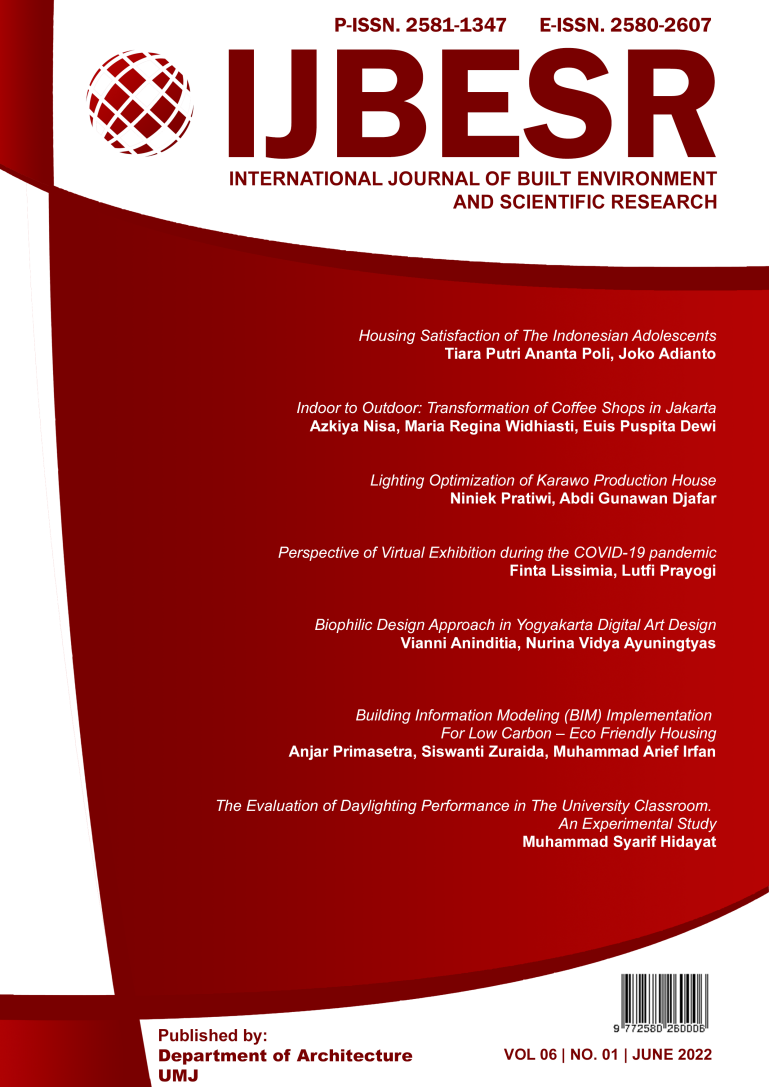Indoor to outdoor: Transformation of Coffee Shops in Jakarta
DOI:
https://doi.org/10.24853/ijbesr.6.1.17-32Keywords:
coffee shop, urban, outdoor, negotiation, commodificationAbstract
From the colonial period to the Covid-19 pandemic, coffee cafes in Jakarta have seen significant changes. Coffee shops as public places must adjust to the pandemic situation by reducing their operating activity to prevent the virus from spreading. This adaption process then prompts coffee industry participants to come up with ways to keep coffee consumption habits consistent, such as employing outdoor spaces that are similar to rural aspects in urban settings. This study will examine the transition of coffee shops in the new normal era of the Covid-19 pandemic, building on prior research on the meaning of traditional-modern coffee shops and the performance of interior design in coffee shops. In addition, this research aims at the meaning of open space and how it relates to consumption patterns. The research method used is a literature review with in-depth analysis in order to solve issues that are related to the subject. The findings reveal that the current open space trend is a negotiation between urban-rural and public-private places. This tendency, however, poses a dilemma in terms of the monetization of the artistic portrayal of rural components adopted by coffee shops in Jakarta.References
Sudiartini, N. W. A., Astari, A. A. E., Kardini, N. L., & Dhani, Y. R. The feasibility study of coffee house business opportunity in COVID-19 pandemic: a case study at kulo coffee shop pemogan. International Research Journal of Management, IT and Social Sciences, 2020; 7(5), 38–45.
Adi Prasetya U, Ujang S, Arif Imam S. Influences of Product Attributes and Lifestyles on Consumer Behavior: A Case Study of Coffee Consumption in Indonesia. Journal of Asian Finance, Economics and Business Vol 8 No 5 (2021) 0939–0950 .
Hakim M. The change of the meaning of coffee shop into a space of sociocultural entity (A case study of the community in Makassar City). Kasetsart Journal of Social Sciences Vol. 42 No. 1 (2021): January-March
Haristianti V. Analisis Faktor Kebetahan Pengunjung Coffee Shop Melalui Penilaian Kinerja Elemen Interior. Studi Kasus: Kafe Dan Coffee Shop Di Kawasan L.R.E Martadinata, Bandung. Jurnal Arsitektur Zonasi Vol 4, No 2 (2021)
Oktafarel K.M., Khouw M, Augusta D.N, Arifin. A, Ekomadyo A.S., Susanto V. Coffee Culture and Heritage: (Demystifying the Heritage Value of Coffee Shops inside Historical Buildings in Jakarta and Bandung). Local Wisdom Scientific Online Journal; 2021;13 (1): 51-66.
Haryanto, Sampebulu V., Wikantari R., Harisah A. Informal Public Spaces: Typology Of Coffee Shop Facades In Makassar City. Journal Of Southwest Jiaotong University, 2022; 0258-2724.
Cakranegara P.A; Gerai Kopi di Jakarta dalam Adaptasi Kehidupan Baru. Journal of Tourism Volume 02, Number 02, December 2020, p. 1-7
Rahma, A., Farida I., Marifatullah A. Knowledge Sharing Over Coffe: History-Based Community in Urban Jakarta. Atlatntis Press; Advances in Social Science, Education and Humanities Research
; volume 302.
Lukito Y.N, Xenia A.P. Café as third place and the creation of a unique space of interaction in UI Campus. Earth and Environmental Science 99(2017) 012028.
Nurhasanah S, Dewi C. The Emergence Of Local Coffee Shops In Indonesia As A Counter To American Culture Hegemony. Rubikon, Journal of Transnational American Studies Vol 6, No 1 (2019).
Said, I. The Lifestyle of the Urban Community (Study on Coffee Lovers in coffee Shop Excelso). 2015. Makassar : Universitas Negeri Makassar
Dhillon, J. K., Nadhilah, N., Veronica, N., & Widyani, A. I. Pengaruh Elemen Interior terhadap Kenyamanan Pengunjung Kaitannya dengan Gaya Hidup Modern di Ardent Cofee Pesanggrahan Jakarta Barat. Mezanin, 2019; 1(1), 60–70.
Maspul, K.A., Sidiq, A.R. The Specialty Coffee Trends Post-Pandemic; Study through CoffeeValue Chain in Garut. Academia Letters, 2021; Article 3592.
Muhyiddin. Covid-19, New Normal, dan Perencanaan Pembangunan di Indonesia. Jurnal Perencanaan Pembangunan: The Indonesian Journal of Development Planning. Vol. 4 No. 2 (2020): Edisi Khusus Covid-19 - Juni 2020
Azhar, J.; Gjerde, M.; Vale, B.; Asif, M. Perception of Urban Leftover Spaces: A Comparative Study of Built Environment and Non-Built Environment Participants. Architecture2022,2,231–24
Iveson, K. 2013. “Cities within the City: Do-It-Yourself Urbanism and the Right to the City.” International Journal of Urban and Regional Research 37 (3): 941–956.
Douglas, Gordon C. C. (2014). Do-It-Yourself Urban Design: The Social Practice of Informal “Improvement” Through Unauthorized Alteration. City & Community, 13(1), 5–25.
Pereira, M. (2018). The Role of Color in Architecture: Visual Effects and Psychological Stimuli. Retrieved 28th April, 2019
McKechnie, G. E. (1977). The Environmental Response Inventory in Application. Environment and Behavior, 9(2), 255–276.
Veenhoven, R. The study of life satisfaction. In A Comparative Study of Satisfaction with Life in Europe; Saris, W.E., Veenhoven, R.,
Liu J(, Dalton AN, Lee J (2021) The “Self” under COVID-19: Social role disruptions, self-authenticity and present-focused coping. PLoS ONE 16(9): e0256939.
Debord Guy. Society of the Spectacle. Translated by Ken Knabb. London: Rebel Press, 2006
Warnick, R. (2004). Rural recreation lifestyles: Trends in recreation activity patterns and self-reported quality of life and health – An exploratory study. Journal of Park and Recreation Administration, 20(4), 37-64.







